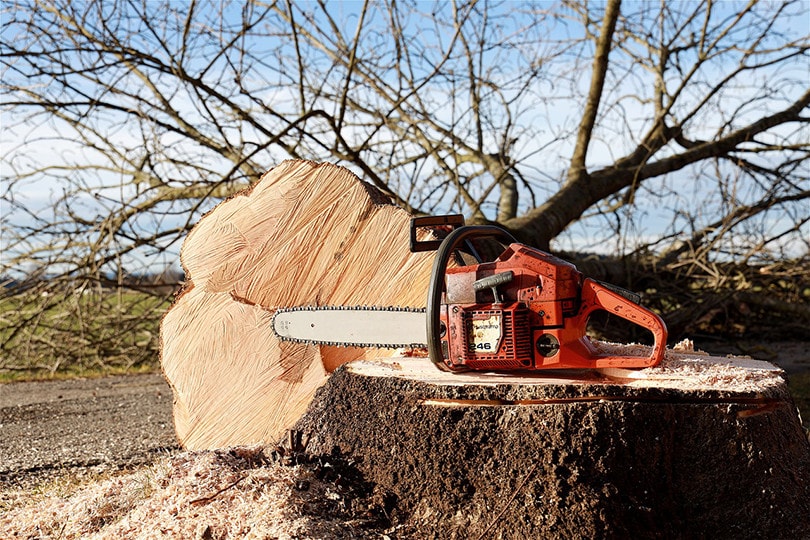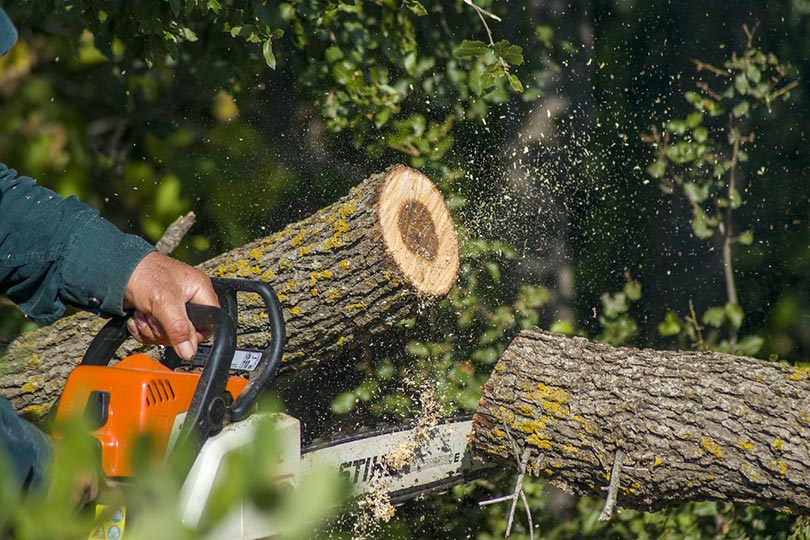How Loud is a Chainsaw in Decibels (dB)? Facts, Types & Protection
-
Shea Cummings
- Last updated:

Not all saws are made equally; there are some very small gas-powered saws that you can almost use without hearing protection. On the other hand, some will ruin your hearing almost instantly if you use them without protection
On average, a gas-powered chainsaw will range from around 100–120 dB. To put that into perspective, from about 80 dB and higher, the potential for hearing damage without hearing protection goes up.
If you expose your ears to 115 dB or higher, the damage and pain can occur almost instantly if you’re not wearing the proper protection.
 Gas-Powered Chainsaws
Gas-Powered Chainsaws
| Brand/Model | dB Rating |
| Stihl: MS 170 | 100 dB |
| Husqvarna: 130 | 102 dB |
| Stihl: MS 271 | 103 dB |
| Husqvarna: 455 Rancher | 104 dB |
| Jonsered: CS2240 | 114 dB |
| Jonsered: CS2255 | 114dB |
| Stihl: MS 500i | 119 dB |
| Husqvarna: 572 XP | 120 dB |

Electric and Battery-Operated Chainsaw
Many brands have corded, electric chainsaws available if the loud sound is an issue. And as the technology improves, battery-operated saws are also improving. Depending on your primary use for the chainsaw, some battery-operated saws will offer you an equal performance to a gas-powered saw.
Below, we’ll look at a few common models on the market to give you an idea of what dB ratings you can expect. Keep in mind that some of these still approach unsafe noise levels to operate without hearing protection.
| Brand/Model | dB Rating |
| Stihl: MSA 160 C-B | 84 dB |
| Echo: Cordless Chainsaw | 87 dB |
| Husqvarna: 120i | 88 dB |
| Stihl: MSA 220 C-B | 89 dB |
| Milwaukee: Fuel Cordless Chainsaw | 93 dB |
| Husqvarna: 540i XP | 95dB |
Protecting Your Ears
Once you lose your hearing, there is no getting it back. So, that’s why it’s so important to protect it. The nice thing about hearing loss due to loud noises—such as chainsaws—is that it’s easy to protect yourself.
Here are a couple of ways that you can protect your hearing.

Make it Convenient
One of the biggest excuses people have about hearing protection is that it’s inconvenient. It’s only one quick cut with the chainsaw; there’s no need to dig out the earmuffs. Over time, that “one cut” builds up, and eventually, the damage is done.
Simply having your hearing protection handy is a huge help in making it convenient. For example, stashing some earbuds in your pocket that you can pop in if you’re working with a saw. If it’s an all-day affair, earmuffs will be more comfortable.
Proper Equipment Maintenance
Chainsaws are loud, and there’s no escaping that. However, their design includes components that help dull some of that noise. With proper maintenance, you can ensure that your saw is actually running according to its rated dBs.
This is important when determining which hearing protection to use. For example, a pair of earbuds may only be good to 110 dB, so if your saw is 120 dB or more, you’ll need different protection.

Different Types of Hearing Protection
Different tools and tasks will require different types of hearing protection. Depending on the noise-reduction rating (NRR) of the plug and the noise level of the task, multiple types of hearing protection are sometimes needed. Here are three common choices.
- Single-Use Plugs: These plugs are typically made from expanding foam. To insert it in your ear, you roll it in your fingers to compress it. When you put it into your ear, it expands to block sound. Usually, a foam plug has an NRR of 20 dB.
- Reusable Plugs: A reusable plug is usually made from silicone or plastic. They are often a one-size-fits-most plug, but some brands offer various sizes. Because they don’t expand the same way as a foam plug, it may take a few tries to get the right size for your ears. However, they are usually more comfortable and offer a better NRR at around 30 dB.
- Earmuffs: Many people don’t like things going in their ears, so earmuffs are a less intrusive safety option. They offer an average NRR of 30 dB. Depending on how loud the environment you are working in is, sometimes double ear protection is recommended. This will be a plug of some kind and earmuffs over top of them.
 Conclusion
Conclusion
You can’t avoid the noise outside of using a quiet, electric chainsaw. Some of the big gas-powered chainsaws can damage your hearing instantly. So, we hope that knowing a bit about the potential dB ratings you could be dealing with while operating a chainsaw will give you the information you need to protect yourself.
Featured Image Credit: Pixabay
Contents
 Gas-Powered Chainsaws
Gas-Powered Chainsaws